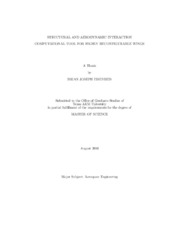| dc.description.abstract | Morphing air vehicles enable more efficient and capable multi-role aircraft by adapting their shape to reach an ideal configuration in an ever-changing environment. Morphing capability is envisioned to have a profound impact on the future of the aerospace industry, and a reconfigurable wing is a significant element of a morphing aircraft. This thesis develops two tools for analyzing wing configurations with multiple geometric degrees-of-freedom: the structural tool and the aerodynamic and structural interaction tool. Linear Space Frame Finite Element Analysis with Euler-Bernoulli beam theory is used to develop the structural analysis morphing tool for modeling a given wing structure with variable geometric parameters including wing span, aspect ratio, sweep angle, dihedral angle, chord length, thickness, incidence angle, and twist angle. The structural tool is validated with linear Euler-Bernoulli beam models using a commercial finite element software program, and the tool is shown to match within 1% compared to all test cases. The verification of the structural tool uses linear and nonlinear Timoshenko beam models, 3D brick element wing models at various sweep angles, and a complex wing structural model of an existing aircraft. The beam model verification demonstrated the tool matches the Timoshenko models within 3%, but the comparisons to complex wing models show the limitations of modeling a wing structure using beam elements. The aerodynamic and structural interaction tool is developed to integrate a constant strength source doublet panel method aerodynamic tool, developed externally to this work, with the structural tool. The load results provided by the aerodynamic tool are used as inputs to the structural tool, giving a quasi-static aeroelastically deflected wing shape. An iterative version of the interaction tool uses the deflected wing shape results from the structural tool as new inputs for the aerodynamic tool in order to investigate the geometric convergence of an aeroelastically deflected wing shape. The findings presented in this thesis show that geometric convergence of the deflected wing shape is not attained using the chosen iterative method, but other potential methods are proposed for future work. The tools presented in the thesis are capable of modeling a wide range of wing configurations, and they may ultimately be utilized by Machine Learning algorithms to learn the ideal wing configuration for given flight conditions and develop control laws for a flyable morphing air vehicle. | en |


